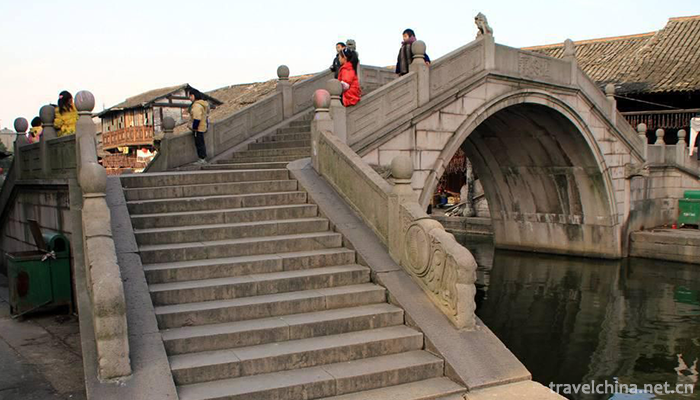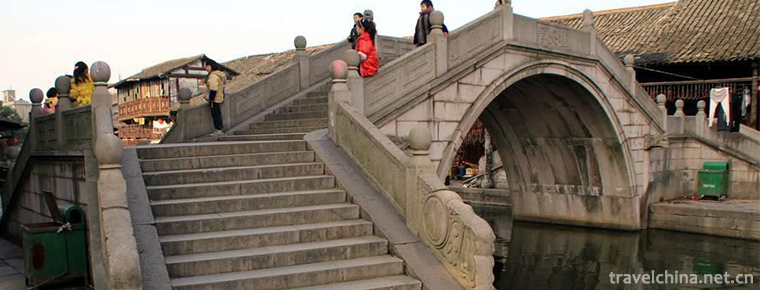Construction Techniques of Stone Bridge
Construction Techniques of Stone Bridge
Shiqiao construction technology, Shaoxing City, Zhejiang Province, local traditional architectural skills, one of the national intangible cultural heritage.
Shaoxing's ancient bridge construction techniques can be traced back to the Spring and Autumn Period and the Warring States Period. To the Han Dynasty, the stone arch bridge construction techniques became more and more mature, the bridge construction techniques in Tang and Song Dynasties improved continuously, and the stone bridge construction techniques in Qing Dynasty developed to the peak period.
In 2008, the Shiqiao construction technology declared by Shaoxing City, Zhejiang Province, was approved by the State Council of the People's Republic of China and listed in the second batch of national intangible cultural heritage list, project number_-176.
historical origin
Shaoxing's ancient bridge construction techniques should be traced back to the floating bridge and wooden beam bridge before the Spring and Autumn Period and the Warring States Period. During the Yue Guo Period, new components such as stone pillars, stone beams and stone bridge decks were used in the construction of ancient bridges because of the appearance of iron tools, which entered the initial period of stone beam bridge. By the Han Dynasty, stone arch bridge construction technology had been quite mature, and it was also applied in bridge construction in Shaoxing. The Qin and Han Dynasties were the period of the construction and development of Shaoxing Bridge. During the Tang and Song Dynasties, the canal and post roads in Shaoxing were smooth and the industry and commerce were developed, which made the construction techniques of bridges continuously improved. At the same time, the development of Shaoxing Stone Bridge entered its heyday.
By the Qing Dynasty, the construction technology of Shiqiao had reached its peak. Shaoxing Shiqiao is already quite large-scale. According to the "Shaoxing Fucheng Qu Road Map" drawn in 1893, there were 229 bridges in the city, with an average area of 7.4 square kilometers. There was a bridge every 0.0231 square kilometers. Stone bridges covered all parts of the city. Every short road, a stone bridge would be seen. "No bridge makes no city, no bridge makes no road, no bridge makes no village" is no exaggeration. At the end of 1993, there were 10 610 bridges in Shaoxing.
Technological characteristics
Shaoxing Shiqiao has unique construction skills. Some of the stone bridges (such as the Baziqiao, Guangning Bridge, etc.) are rare in China. Bridges in various forms form a very systematic technical system, which is in the leading level in the country at various times. Moreover, the construction technology of stone bridges is very scientific, the quality of materials is exquisite, the layout and site selection are reasonable, and the general life of ancient stone bridges can be more than a thousand years.
There are 704 stone bridges in Shaoxing, which is the largest number of stone bridges in one region of China. At the same time, Shaoxing is also one of the areas with the largest number of cultural relics protection units in Shiqiao. There are 13 ancient stone bridges in Shaoxing City, including ancient fibre road bridge, eight-way bridge, Guangxiang bridge, Guangning bridge, Silong bridge, Taiping bridge, Xie Gong bridge, Tifan bridge, Ying En bridge, Baiwang bridge, bridging bridge, Rongguang bridge, Jingkou bridge and West Lake bridge. There are 6 ancient stone bridges in provincial cultural relics protection units, such as Sanjiang Gate Bridge, and 38 ancient stone bridges in County (city) level cultural relics protection units, such as Longqiao.
Good quality: Shaoxing Shiqiao has 23 bridge types, constituting a complete series of stone bridges, some of which exist alone in Shaoxing and are no longer visible in other places. For example, in the "most technological construction of stone bridges", the Bazi Bridge, which was built in the Southern Song Dynasty, is the oldest existing urban bridge in China. The Guangning Bridge, which was built in the Southern Song Dynasty, is the oldest seven-fold-edged arch overpass in China. Yingxian Bridge and Yucheng Bridge are the earliest catenary Arch-Stone bridges in the Ming and Qing Dynasties. The ancient fibre road bridge is the only multi-bridge built along the river in the Tang Dynasty. Composite bridges and so on. Another example is the scientific arrangement of the soft soil foundation of Hutang Bridge in Han Dynasty unearthed from Shaoxing Lake, which is the earliest example of the soft soil foundation of China.
Longevity: The design life of contemporary bridges is about one hundred years, while the life of Shaoxing stone bridges can be more than one thousand years. This longevity originates from the scientific construction technology of Shaoxing Shiqiao, the quality of the stone materials and the reasonable layout and site selection. For example, the timber used in the construction of stone bridges is mostly pine, which has the reputation of "a thousand-year-old bottom pine". Pine is used as bridge columns and bridge piles can be preserved. The wooden piles unearthed in the foundation of Shaoxing Shiqiao are far from the Han Dynasty, and they can be well preserved when unearthed.
Inheritance and Protection
Inheritance value
Shaoxing Shiqiao not only creates superb skills, but also has profound cultural connotations, showing a very high aesthetic value. Its aesthetic feeling in environmental layout, structural decoration and other aspects makes people fully appreciate the unique magic charm of Jiangnan water culture. "Rainbow Jade comes with the door and the famous Wangu Bridge goes out of Yuezhou." Shaoxing Shiqiao culture has already become an important part of Yue culture.
Current situation of inheritance
In the market economy era, due to the high cost and complicated technology of stone bridge construction, general construction companies are reluctant to undertake construction. This makes Shaoxing Shiqiao construction technology gradually declining trend, inheritance of the lack of successors, and actively protect this advanced folk architectural technology has become an urgent task.
Heritage figures
Luoguanzhou, male, born in 1945. On November 5, 2009, Luoguanzhou was selected as the representative successor of the second batch of Shaoxing-level intangible cultural heritage projects. Shaoxing City, Zhejiang Province, declared the project: Shiqiao construction technology.
protective measures
On August 8, 2012, Zhejiang Sincerity Construction Co., Ltd. and Zhejiang Zhonglian Classical Garden Architecture Branch were selected to build a technology base for Shiqiao, and the construction technology of Shiqiao was protected.
On August 1, 2018, in the announcement of Shaoxing Municipal Bureau of Culture and Guangzhou and Shaoxing Bureau of Education on the recommendation list of the second batch of teaching heritage bases of Shaoxing intangible cultural heritage, Zhejiang Polytechnic Institute declared that it would build a technology base for Shiqiao.
On June 15, 2016, Luoguanzhou, the inheritor of "Shiqiao Construction Techniques", led nearly 100 teachers and students of Zhejiang Polytechnic of Industry to carry out on-the-spot survey of two ancient bridges in Jinghu New Area of Shaoxing.
social influence
Important Exhibitions
On September 3, 2014, the "Shiqiao Building Skills Exhibition" jointly organized by Shaoxing Science and Technology Association, Municipal Bureau of Culture and Guangzhou, Municipal Bureau of Cultural Relics and Municipal Ancient Bridge Society was held in the Municipal Cultural Museum. The Shiqiao Building Skills were displayed.


-
2.Island Jinshan Temple
Jinshan Temple, located in the northern part of Qingyun County, Dezhou City, Shandong Province, was built in the Sui Dynasty and flourished in the Tang Dynasty. It is said that the island Jinshan Temp
Time 2019-01-13 -
3.rime island
Wuluo Island, an island on the Songhua River, is located in the Manchu town of Ura Street, Longtan District, Jilin Province. The villages of Hantun and Zeng Tongtun in Manchu Town of Ura Street are th
Time 2019-02-25 -
4.Legend of Anima Qingxueshan
The Legend of Anima Qing Snow Mountain refers to the legendary Anima Qing Mountain God, who is a powerful and upright God riding a high-headed white horse, holding a Mani bag (a treasure).
Time 2019-03-28 -
5.Nazikum
Nazikum is a folk dance performance that combines instrumental performance, competitive performance, mime performance and rap. The unique squatting dance is the leading style in Uygur folk songs and d
Time 2019-06-07 -
6.June meeting in Regong
Regong June Festival is a unique traditional cultural festival of Tibetan and Tu villages in Tongren County, Qinghai Province. It has been circulated for more than 1400 years. Every June in the Lunar
Time 2019-06-11 -
7.Legend of Su Dongpo
The legend of Su Dongpo is a group of traditional folklore stories evolved from the story of Su Shi, a great writer in the Northern Song Dynasty.
Time 2019-06-16 -
8.Changsha Tanci
Changsha Tanci is a traditional opera in Hunan Province. It is popular in Changsha, Yiyang, Xiangtan, Zhuzhou and Liuyang of Hunan Xiangjiang River and Zishui River basin. Changsha Tanci derives from
Time 2019-07-25 -
9.Sichuan Conservatory of Music
Sichuan Conservatory of Music, whose predecessor was "Sichuan Provincial Drama Education Experimental School" founded in 1939, has experienced such periods as "Sichuan Provincial Music
Time 2019-08-31 -
10.Luzhou cuisine
Sichuan hotpot, famous for its hemp, spicy, fresh and fragrant, is the representative of Sichuan cuisine. It is said that the birthplace of Sichuan hotpot is xiaomitan in Luzhou (near Gaoba, Luohan street, Longmatan District).
Time 2020-12-14 -
11.Social security in Deyang
In 2018, there were 748000 employees participating in basic endowment insurance, 345000 in unemployment insurance, 752000 in medical insurance, 384000 in industrial injury insurance and 399000 in maternity insurance. In the whole year,
Time 2020-12-14 -
12.Meishan economy
In 2019, the gross domestic product (GDP) will reach 138.02 billion yuan, an increase of 7.5%. Among them, the added value of the primary industry was 19.916 billion yuan, an increase of 3.0%; the added value of the secondary industry was 52.713 billion yuan,
Time 2020-12-18